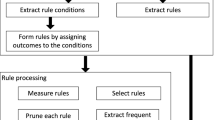Abstract
Decision tree classifiers have been proved to be among the most interpretable models due to their intuitive structure that illustrates decision processes in form of logical rules. Unfortunately, more complex tree-based classifiers such as oblique trees and random forests overcome the accuracy of decision trees at the cost of becoming non interpretable. In this paper, we propose a method that takes as input any tree-based classifier and returns a single decision tree able to approximate its behavior. Our proposal merges tree-based classifiers by an intensional and extensional approach and applies a post-hoc explanation strategy. Our experiments shows that the retrieved single decision tree is at least as accurate as the original tree-based model, faithful, and more interpretable.
Access this chapter
Tax calculation will be finalised at checkout
Purchases are for personal use only
Similar content being viewed by others
Notes
- 1.
We use \(T_i\) for DT, rule tables, decision tables, and decision regions.
- 2.
We highlight that also oblique trees can adopt as best split a traditional split.
- 3.
Python code and datasets available at: https://github.com/valevalerio/SAME. Experiments run on Ubuntu 20.04 LTS, 252 GB RAM, 3.30GHz x 36 Intel Core i9.
- 4.
The datasets are available on same Github, on the UCI repository https://archive.ics.uci.edu/ml/index.php, and on Kaggle https://www.kaggle.com/datasets.
- 5.
scikit-learn: https://scikit-learn.org/, [17] Github repository https://github.com/TorshaMajumder/Ensembles_of_Oblique_Decision_Trees.
- 6.
max depth \(\in \{5,6,7,8,10,12,16, unbounded \}\), class weight \(\in \{ normal , balanced \}\).
- 7.
Details of the parameters tested can be found in same repository.
- 8.
We highlight that even though they can have the same performance there is no guarantee that the mis-classification errors are the same.
References
Andrzejak, A., et al.: Interpretable models from distributed data via merging of decision trees. In: CIDM, pp. 1–9. IEEE (2013)
Craven, M.W., et al.: Extracting tree-structured representations of trained networks, pp. 24–30 (1995)
Domingos, P.M.: Knowledge discovery via multiple models. Intell. Data Anal. 2(1–4), 187–202 (1998)
Dougherty, J., et al.: Supervised and unsupervised discretization of continuous features. In: ICML, pp. 194–202. Morgan Kaufmann (1995)
Fan, C., et al.: Classification acceleration via merging decision trees. In: FODS, pp. 13–22. ACM (2020)
Guidotti, R., et al.: A survey of methods for explaining black box models. ACM Comput. Surv. 51(5), 93:1–93:42 (2019)
Hall, L.O., et al.: Combining decision trees learned in parallel. In: Working Notes of the KDD-97 Workshop on Distributed Data Mining, pp. 10–15 (1998)
Ho, T.K.: The random subspace method for constructing decision forests. IEEE Trans. Pattern Anal. Mach. Intell. 20(8), 832–844 (1998)
Johansson, U., et al.: Evolving decision trees using oracle guides. In: CIDM, pp. 238–244. IEEE (2009)
Krishnan, R., et al.: Extracting decision trees from trained neural networks. Pattern Recognit. 32(12), 1999–2009 (1999)
Micci, D.: A preprocessing scheme for high-cardinality categorical attributes in classification and prediction problems. SIGKDD Explor. 3(1), 27–32 (2001)
Miller, T.: Explanation in artificial intelligence: Insights from the social sciences. Artif. Intell. 267, 1–38 (2019)
Sagi, O., Rokach, L.: Explainable decision forest: transforming a decision forest into an interpretable tree. Inf. Fusion 61, 124–138 (2020)
Strecht, P.: A survey of merging decision trees data mining approaches. In Proceedings of10th Doctoral Symposium in Informatics Engineering, pp. 36–47 (2015)
Strecht, P., Mendes-Moreira, J., Soares, C.: Merging decision trees: a case study in predicting student performance. In: Luo, X., Yu, J.X., Li, Z. (eds.) ADMA 2014. LNCS (LNAI), vol. 8933, pp. 535–548. Springer, Cham (2014). https://doi.org/10.1007/978-3-319-14717-8_42
Tan, S., et al.: Tree space prototypes: another look at making tree ensembles interpretable. In: FODS, pp. 23–34. ACM (2020)
Torsha, M.: Ensembles of oblique decision trees (2020)
Wickramarachchi, D.C., et al.: HHCART: an oblique decision tree. Comput. Stat. Data Anal. 96, 12–23 (2016)
Acknowledgment
Work partially supported by the European Community H2020 programme under the funding schemes: G.A. 871042 SoBigData++, G.A. 761758 Humane AI, G.A. 952215 TAILOR and the ERC-2018-ADG G.A. 834756 “XAI: Science and technology for the eXplanation of AI decision making”.
Author information
Authors and Affiliations
Corresponding author
Editor information
Editors and Affiliations
Rights and permissions
Copyright information
© 2021 Springer Nature Switzerland AG
About this paper
Cite this paper
Bonsignori, V., Guidotti, R., Monreale, A. (2021). Deriving a Single Interpretable Model by Merging Tree-Based Classifiers. In: Soares, C., Torgo, L. (eds) Discovery Science. DS 2021. Lecture Notes in Computer Science(), vol 12986. Springer, Cham. https://doi.org/10.1007/978-3-030-88942-5_27
Download citation
DOI: https://doi.org/10.1007/978-3-030-88942-5_27
Published:
Publisher Name: Springer, Cham
Print ISBN: 978-3-030-88941-8
Online ISBN: 978-3-030-88942-5
eBook Packages: Computer ScienceComputer Science (R0)




